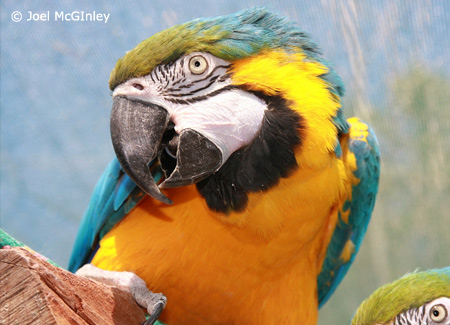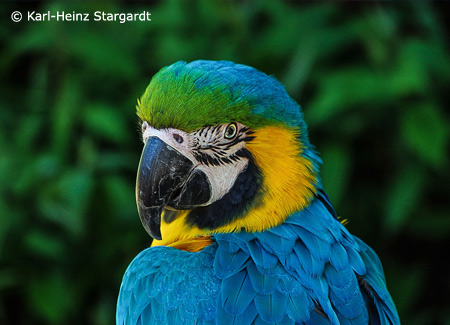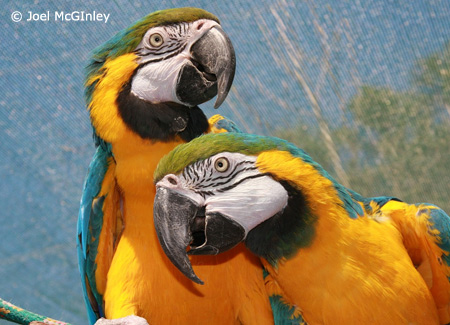[bars]
Common Names: Blue and Gold Macaw, Blue and Yellow Macaw
Scientific Name: Ara ararauna
Origin: South America (Venezuela, Peru, Brazil, Bolivia, and Paraguay)
Relative Size: 34 inches
Weight: 900-1500 grams
Average Lifespan: 50-60 years
Egg Clutch: 2-3 white eggs
Incubation: days: 28 days
Talking Ability: Moderate
Description

Blue and Gold Macaws are stunning specimens to look at. Both male and female look identical in color and size. Their bodies are literally bathed in gold and blue, hence they are given their name the Blue and Gold Macaw. These striking birds have long tails that extend roughly 2 feet out and are comprised of 12 large feathers. When the bird is perched, blue is the main color. The nape area of this macaw is a forest green.
Like all macaws, these birds have bare faces with white skin. In the case of a Blue and Gold Macaw, black feathers grow in stripes on the white skin giving these birds a zebra like appearance.
[ads]
Their eyes are a vivid florescent yellow with black pupils. When these birds are excited, the pupil constricts to a tiny dot. The beak and feet are charcoal black. Underneath the beak, a black coat of feathers gives this bird the appearance of a beard.
Juvenile macaws have black eyes that will start to lighten when the bird is roughly 5 months of age. As the bird matures, the eyes will become lighter. Some Blue and Gold Macaws can take as long is 2 years to get their full eye color.
Blue and Gold Macaws In the Wild
These Macaws are native to South America and live mostly in the center of South America. In fact, some can be found in Central America as well. These birds can be spotted in Brazil, Bolivia, Paraguay and Peru.
In the wild, these birds form close-knit groups. These gregarious parrots will spend time with their flock mates playing, bathing, and searching for ripe fruits throughout the rain forests. Most of their diet is comprised of palm nuts, seeds, and fruits.
When food is scarce the birds are forced to eat fruit that is not ripe, or toxic plants, that may upset their stomachs. To combat any illness or parasitic infections, the birds consume clay by river beds. In fact, the clay is also thought to provide the birds with minerals that cannot be obtained from fruits and seeds. Nevertheless, these birds often flock with other parrots while consuming clay.
Like any typical macaw, Blue and Gold Macaws do enjoy the company of their flock mates; however, the birds do branch off during the breeding season where they raise their young. The mother will look for a hollow tree, usually a safely guarded nesting site, or broken palm tree, that she’ll hollow out and clean before she deposits two or three white eggs.
Once the babies hatch, the mother and father will both feed the babies until they fledge. The mother will stay with the babies inside the nesting cavity until the young birds start to feather out and the food demand increases. When the babies fledge, at roughly three months, they will stay with their parents for a few extra months before they venture off on their own.
Blue and Gold Macaws In Captivity

Relatively speaking, Blue and Gold Macaws are not threatened in the wild and are abundant in captivity. These birds have a marvelous personality and make great pets for those who enjoy more experienced creatures. In fact, of all the larger macaw species available on the market, the Blue and Gold Macaw is perhaps the most popular due to their easy breeding habits and pricing.
These birds are common in bird shows or wild animal parks that showcase large aviaries. Because of their striking colors and boisterous personalities, they are definitely crowd drawers.
If someone is looking to purchase such a specimen, their best chances would be to look online for a breeder, animal shelters, or talking to breeders at bird shows. Finding these parrots is not difficult and many can even be adopted from bird rescue sanctuaries.
Pet Aspect
Similar to humans, each bird has its own distinctive personality and characteristics as well as those that are common to its species. Thus, a macaw’s mood and behavior will alter according to its emotions, mental state, surroundings, and health conditions. However, due to their high intelligence, friendliness, curiosity, mild temper, and playfulness, these macaws are easy to socialize and train, especially if they are very young birds. This socialization and training helps the bird set its boundaries and develop the necessary confidence, social skills and a deep sense of security. Nevertheless, these macaws may become aggressive, rebellious, and territorial on some occasions, despite being affectionate birds.
People who are extremely busy, away from home frequently, or intolerant of loud noises should consider getting a different pet. Blue and Gold Macaws become very agitated if given too much solitude. Well-known for being very vocal, they frequently utter raucous calls and loud screams, especially around dusk or when excited. Therefore, macaw owners must take into consideration how they will keep their birds’ incessant noises from disturbing the owner, any neighbors or other family members.
Out of the 17 subspecies of macaws, the Blue and Gold specie has the best ability to mimic human speech. Yet, even they have very limited abilities. However, with adequate human interaction, these macaws may learn how to use some words and phrases. Still, some birds may choose not to use human speech or may be less capable of it. Nevertheless, all Blue and Gold Macaws are very expressive communicators via verbal and non-verbal languages.
Unfortunately, most owners are often misled as young macaws tend to be shy and reserved and are somewhat quiet. Only when the bird starts to mature and explore do they realize the scope and volume of such a call. Quite frankly, at times their calls can be deafening. This should really be taken into consideration as all too often these birds are re-homed time and time again due to owners not expecting such loud vocalizations.
When treated as a dearly loved member of the owner’s family, Blue and Gold Macaws provide a lifetime’s worth of devoted affection, entertainment and companionship. Consequently, macaw owners must remain emotionally, financially, and physically committed to the relationship for 30-50 years, if not longer. They must also ensure the macaw will be well cared for in case the owner dies before the bird does.
Similar to humans, macaws bore easily and are unhappy if they lack adequate mental stimulation, physical activity and social interaction. When interacting with their owners, Blue and Gold Macaws enjoy a wide range of activities such as eating with their owner, going to parks and playgrounds, hiking, learning and performing tricks, playing games, solving puzzles and problems, watching TV and movies, and listening to the radio.
The most mentally happy and healthy macaw is one who is incorporated into its household like a family member.
Also, utilizing clipped wings, bird leashes and bird car seats makes it safer and easier to take pet macaws out in the public. Nonetheless, most experts recommend that owners deny their birds the permission to ride on anyone’s shoulder due to the possibility of severe damage to the person’s face. This is due to the tendency that birds can bite when they become agitated or startled, and all birds are easily startled.
Because these birds have such large beaks, and can at times become overexcited, it is wise for the owners to start a positive reinforcement program along with proper socialization early on. All negative behaviors should be completely ignored while desiring behaviors rewarded.
Breeding

Blue and Gold Macaws are not sexually dimorphic, meaning that there are no obvious differences between the males and females. Determining a male from a female is nearly impossible for a human. For this reason, DNA testing is the only reliable way to determine the parrot’s sex. Once this has been successfully achieved, pairing the birds can be tried, and if all goes well, then breeding can commence.
It should be noted that these birds can sometimes be finicky when it comes to picking their mates. In most cases, breeders will successfully pair birds by simply placing a male and female together. There are times when this tactic is not successful and the only option is for the bird to select its own mate.
Once a mate is selected, the bonding process will begin. This takes several weeks and the birds will preen, fly, and eat together. These bonding activities over time strengthen the macaws’s bond, so much so, that these birds will stay together for life. Other bonding activities include the male regurgitating to the female, preening, and loud vocalizations to each other.
If you’re thinking about breeding these birds in residential areas, think again! These birds are very loud during breeding and sometimes the birds will have to be removed due to disgruntled neighbors. That being said, you should check with your neighbors before such a production is set up.
These birds are not picky when it comes to selecting nesting cavities. In the wild, these birds look for cavities high in the forest canopy. For this reason, breeders should place nesting boxes higher up, yet in such a position that the birds can be observed.
The nesting boxes used for these birds are usually large wooden crates, logs, old wine barrels, or plastic bins. It is best the nesting box be suspended outside the aviary as sometimes these parrots will chew them up. Having extra support at the bottom of the nesting box is also advised too. When the female is ready to lay her eggs, she will spend hours cleaning the box out and removing all debris from the bottom of the box. When a dedicated female macaw does this, it’s always wise to add a few handfuls of wood shaving back into the nest to ensure the eggs have padding.
Once the nesting site has been selected and properly prepared by the female, the birds will mate several times side by side. This will continue frequently, until three eggs are laid. Sometimes, these birds can produce four; however, this seems to be rare. The eggs can be laid several days apart and incubation usually starts once the second egg is laid. Incubation of the eggs is roughly 28 days, sometimes a few days over.
When the babies hatch, the mother will care for them many months after they fledge.
Caging/Housing
Blue and Gold Macaws require large cages, preferably durable suspended cages that are 5’x5’x8’ or larger. Each cage must provide opportunities for the macaw to climb, perch, play, and interact with toys and humans. Therefore, the cage must allow room for the full extension of the bird’s wings. A female typically has a 3’ wingspan and a male typically has a 3 ½’ wingspan.
The cage has to be made of 10-gauge to 12-gauge welded wire or chain link. The bars should not be any further apart than 1 inch. Furthermore, replacing the cage latches with locks and escape-proof latches may be advisable, since many Blue and Gold Macaws are very adept at opening latches.
Whenever possible, owners should provide both, an indoor and outdoor cage for the macaw. Birds need lots of sunshine, exercise and a place to bathe frequently, since bathing is essential to their health. Bathing the bird and letting it dry off in sunlight is much easier to do in an outdoor cage than in an indoor cage.
All birds also need adequate amounts of sleep that is uninterrupted by noises and bright lights. Therefore, placing the cage in a quiet part of the house during the night is advisable. Avoid placing the cage near air conditioners, air vents, and other drafty places.
Moreover, owners must allow their macaws out of their cages for at least a few hours each day, whether indoors or outdoors. Since the birds can harm themselves or personal property, the owner must provide constant supervision while the macaws are free of their cages. Similar to childproofing, the entire home must be bird-proofed. This means keeping all electric cords, jewelry, shining objects, toxic chemicals, harmful food items, and small items out of reach of the inquisitive macaw. It also means ensuring the macaw does not chew on wooden furniture, window frames or picture frames.
Playtime Toys
Placing a variety of toys inside and outside of the cage is essential to the macaw’s mental health. Switching and adding new toys frequently will avert boredom. The toys should include chew toys, puzzle toys, a play set, and foraging toys that hide food treats and other toys. Macaws love to chew, so wooden blocks and branches made from non-toxic wood is a real treat for the macaw. Blue and Gold Macaws also enjoy dragging their favorite toy around the house. However, they will also put away their toys when done playing with them, if properly trained to do so.
Feeding Pet Macaws

Very young birds require a high-fat diet with additional protein, so this will require purchasing a commercial diet specializing in hand feeding formula for growing macaw chicks. As the birds mature, they will require a varied diet. They require fresh fruits and vegetables, as well as some fatty acids, nuts, and whole grains and protein. Adult macaws require being fed approximately a 1/4-cup of formulated pellets supplemented by a half cup of fruits and vegetables once a day, and 1/4 cup of your bird’s favorite nut mix. Additionally, providing fresh, pure water daily is essential, as they typically dunk their food in water.
Blue and Gold Macaws like eating most types of fruits and vegetables. Nonetheless, some foods should only be fed in limited amounts, especially those in the high acid and high-sugar food groups. Macaws will also eat alfalfa leaf, basil, and other types of greens and herbs. Moreover, removal of all the seeds and pits is essential, as some are quite toxic to birds.
People who plan to feed their Blue and Gold Macaws a strict diet of only birdseed or only formulated pellets should consider getting a different pet. These birds cannot survive without having a varied diet that is natural and organic. Most macaw owners find themselves preparing meals throughout the week to ensure these birds are fed well. Not only is a varied diet a must for optimal health, but these birds need different textures, tastes, and colors to remain happy.
Foods to be Avoided
Macaws must avoid certain foods and beverages. They must avoid avocados, onions, raw beans, rhubarb leaves, eggplants, potatoes, and nutmeg. Macaws must also avoid any lactose product (i.e. Milk) as they cannot digest any dairy product. Additionally, they must avoid alcoholic beverages, tobacco products, salted products, and caffeine (i.e. in chocolate, coffee, tea, sodas).
Lifespan
Much confusion exists as to what the average lifespan for this species is, especially in captivity. Some say the average lifespan is 30-35 years, while others say that 40 years is average. Yet other macaw experts insist that the average lifespan is 50-70 years. Some Blue and Gold Macaws, such as Charlie the Cursor, have lived for over a hundred years. According to her owners, Charlie turned 112 in 2011. Despite not being able to agree on the average lifespan, all owners and expert concur that owning a Blue and Gold Macaw requires a huge amount of commitment.
[ads]
